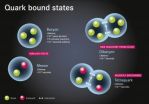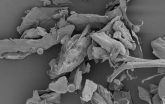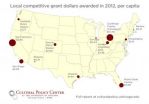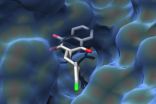(Press-News.org) This news release is available in French.
For decades, physicists have searched in vain for exotic bound states comprising more than three quarks. Experiments performed at Jülich's accelerator COSY have now shown that, in fact, such complex particles do exist in nature. This discovery by the WASA-at-COSY collaboration has been published in the journal Physical Review Letters. The measurements confirm results from 2011, when the more than 120 scientists from eight countries discovered for the first time strong indications for the existence of an exotic dibaryon made up of six quarks.
For a long time, physicists were only able to reliably verify two different classes of hadrons: volatile mesons comprising one quark and one antiquark and baryons consisting of three quarks. Protons and neutrons, which make up atomic nuclei, are examples of the latter. In recent years, however, there has been growing evidence for the existence of additional types of hadrons, for example, hybrids, glueballs, and multiquarks. In 1964, the physicist Freeman Dyson was the first to predict such more complex states. But any reliable verification proved impossible for many years because almost no measurements could be reproduced.
Only recently, other research groups – independently of each other – found strong indications for short-lived, exotic particles comprising four quarks, so called "tetraquarks". The new bound state, which has now been verified at COSY, means that yet another class of exotic particles has been identified. "The new resonance that we observed confirms that quarks really do exist in six-packs. This discovery could open the door to new physical phenomena," says group spokesman Prof. Heinz Clement from the University of Tübingen.
The structure that was first discovered in 2011 is extremely short-lived and could only be detected via its decay products. The transient intermediate state – technical term: resonance – exists for a mere hundred-sextillionth (10 to the power of -23) of a second before it decays. This time span is so short that, for example, light can travel just a distance equivalent to the diameter of a small atomic nucleus.
Whether all six quarks form a single compact entity or rather a "hadronic molecule" has yet to be clarified. The latter would be composed of several nuclear building blocks – for example of excited protons and neutrons bound to each other – yet much more strongly than inside an atomic nucleus.
"The measurements that we performed at COSY in 2011 were already very precise. But because the experiments could not be repeated at any other accelerator worldwide, we had to come up with another experiment to verify the results," explains Prof. Hans Ströher, director at the Nuclear Physics Institute (IKP-2) in Jülich.
In order to gain further unequivocal evidence of the exotic resonance named d*(2380), the scientists scanned the relevant energy range in an elastic scattering experiment. They bombarded a proton target with polarized, heavy hydrogen nuclei known as deuterons. The exotic bound state formed during the collision influenced the angle with which the particles moved away from each other after the collision, thus allowing it to be identified .
"The findings are part of a bigger picture. If this particle exists, then theoretically a whole range of other exotic states can be expected," says director at Jülich's IKP-1 Prof. James Ritman. The nuclear physicist is in charge of Jülich's contribution to the PANDA detector at the international accelerator complex FAIR in Darmstadt, where such exotic structures will be explored in more detail.
INFORMATION: END
Exotic particle confirmed
COSY accelerator: Quarks in 6-packs
2014-06-06
ELSE PRESS RELEASES FROM THIS DATE:
Early exposure to certain bacteria may protect toddlers from wheezing
2014-06-06
WHAT: Research funded by the National Institutes of Health (NIH) suggests that exposure to specific combinations of allergens and bacteria within the first year of life may protect children from wheezing and allergic disease. These observations come from the Urban Environment and Childhood Asthma (URECA) study, which aims to identify factors responsible for asthma development in children from inner-city settings, where the disease is more prevalent and severe. Since 2005, the URECA study has enrolled 560 children from four cities—Baltimore, Boston, New York and St. Louis. ...
New report: Local public grants for art varies across US
2014-06-06
Local direct public funding provided through grants for the arts in Chicago is low compared to peer regions in both total dollar and per capita terms, according to a new report from the Cultural Policy Center at the University of Chicago.
The study tracks direct public funding for the arts in 13 regions from 2002-2012. It provides a nuanced look at how much money comes to the nonprofit arts from national, state and local arts agencies, with an emphasis on the important role of local arts agencies. While most studies of public funding for the arts use appropriations made ...
HIV transmission networks mapped to reduce infection rate
2014-06-06
Researchers at the University of California, San Diego School of Medicine have mapped the transmission network of human immunodeficiency virus (HIV) in San Diego. The mapping of HIV infections, which used genetic sequencing, allowed researchers to predictively model the likelihood of new HIV transmissions and identify persons at greatest risk for transmitting the virus.
The findings are published online in the June 5 issue of the journal PLOS ONE.
"The more we understand the structure and dynamics of an HIV transmission network, the better we can identify 'hot spots' ...
Alcohol may protect trauma patients from later complications
2014-06-06
Injured patients who have alcohol in their blood have a reduced risk for developing cardiac and renal complications, according to a study from the University of Illinois at Chicago School of Public Health. Among patients who did develop complications, those with alcohol in their blood were less likely to die.
The study is published in the June issue of the journal Alcohol.
"After an injury, if you are intoxicated there seems to be a substantial protective effect," says UIC injury epidemiologist Lee Friedman, author of the study. "But we don't fully understand why this ...
Is glaucoma a brain disease?
2014-06-06
Rockville, Md. — Findings from a new study published in Translational Vision Science & Technology (TVST) show the brain, not the eye, controls the cellular process that leads to glaucoma. The results may help develop treatments for one of the world's leading causes of irreversible blindness, as well as contribute to the development of future therapies for preserving brain function in other age-related disorders like Alzheimer's.
In the TVST paper, Refined Data Analysis Provides Clinical Evidence for Central Nervous System Control of Chronic Glaucomatous Neurodegeneration, ...
Clinical review published in JAMA
2014-06-06
Many women experience bothersome urine loss with laughing, coughing and sneezing (stress urinary incontinence) AND on their way to the bathroom (urge urinary incontinence). When women experience both types of urine leakage, their condition is called mixed urinary incontinence. It is estimated that 20 to 36 percent of women suffer from mixed urinary incontinence, which is challenging to diagnose and treat because symptoms vary and guidelines for treatment are not clear.
A clinical review entitled "Clinical Crossroads – Female Mixed Urinary Incontinence" by Deborah L. ...
Prostate cancer biomarkers identified in seminal fluid
2014-06-06
Improved diagnosis and management of one of the most common cancers in men – prostate cancer – could result from research at the University of Adelaide, which has discovered that seminal fluid (semen) contains biomarkers for the disease.
Results of a study now published in the journal Endocrine-Related Cancer have shown that the presence of certain molecules in seminal fluid indicates not only whether a man has prostate cancer, but also the severity of the cancer.
Speaking in the lead-up to Men's Health Week (9-15 June), University of Adelaide research fellow and lead ...
Toward a better drug against malaria
2014-06-06
This news release is available in German.
A research team led by Prof. Dr. Carola Hunte of the University of Freiburg/ Germany has succeeded in describing how the antimalarial drug atovaquone binds to its target protein. The scientists used x-ray crystallography to determine the three-dimensional structure of the protein with the active substance bound. The drug combination atovaquone-proguanil (Malarone®) is a medication used worldwide for the prevention and treatment of malaria. The data and the resulting findings concerning the mode of action of atovaquone could ...
Football for untrained 70-year-old men
2014-06-06
Research carried out by the Copenhagen Centre for Team Sport and Health in Denmark shows that untrained elderly men get markedly fitter and healthier as a result of playing football (soccer). After only 4 months of twice-weekly 1-hour training sessions, the men achieved marked improvements in maximum oxygen uptake, muscle function and bone mineralization.
Later today, three scientific articles will be published in the Scandinavian Journal of Medicine & Science in Sports describing the fitness and health effects of football training for 63‒75-year-old untrained men. ...
Deadly diseases overlooked for too long, scientists say
2014-06-06
Decades of neglect have allowed infectious diseases to devastate the lives of thousands of people in the developing world, a study reveals.
Researchers say three diseases in particular – anthrax, brucellosis and bovine tuberculosis – have failed to receive the official recognition and funding needed to combat them effectively.
All three impact greatly on human and animal health in developing nations, posing a major threat to safe and plentiful food supplies.
The disorders – known as zoonotic diseases – are spread between animals and humans. They are common ...
LAST 30 PRESS RELEASES:
Scalable and healable gradient textiles for multi‑scenario radiative cooling via bicomponent blow spinning
Research shows informed traders never let a good climate crisis go to waste
Intelligent XGBoost framework enhances asphalt pavement skid resistance assessment
Dual-function biomaterials for postoperative osteosarcoma: Tumor suppression and bone regeneration
New framework reveals where transport emissions concentrate in Singapore
NTP-enhanced lattice oxygen activation in Ce-Co catalysts for low-temperature soot combustion
Synergistic interface engineering in Cu-Zn-Ce catalysts for efficient CO2 hydrogenation to methanol
COVID-19 leaves a lasting mark on the human brain
Scientists use ultrasound to soften and treat cancer tumors without damaging healthy tissue
Community swimming program for Black youth boosts skills, sense of belonging, study finds
Specific depressive symptoms in midlife linked to increased dementia risk
An ‘illuminating’ design sheds light on cholesterol
Who is more likely to get long COVID?
Study showcases resilience and rapid growth of “living rocks”
Naval Research Lab diver earns Office of Naval Research 2025 Sailor of the Year
New Mayo-led study establishes practical definition for rapidly progressive dementia
Fossil fuel industry’s “climate false solutions” reinforce its power and aggravate environmental injustice
Researchers reveal bias in a widely used measure of algorithm performance
Alcohol causes cancer. A study from IOCB Prague confirms damage to DNA and shows how cells defend against it
Hidden viruses in wastewater treatment may shape public health risks, study finds
Unlock the power of nature: how biomass can transform climate mitigation
Biochar reshapes hidden soil microbes that capture carbon dioxide in farmland
Reducing saturated fat intake shows mortality benefit, but only in high-risk individuals
Manta rays create mobile ecosystems, study finds
Study: Mixed results in using lipoic acid to treat progressive multiple sclerosis
Norbert Holtkamp appointed director of Fermi National Accelerator Laboratory
New agentic AI platform accelerates advanced optics design
Biologists discover neurons use physical signals — not electricity — to stabilize communication
Researchers discover that a hormone can access the brain by hitchhiking
University of Oklahoma researcher awarded funding to pursue AI-powered material design
[Press-News.org] Exotic particle confirmedCOSY accelerator: Quarks in 6-packs






